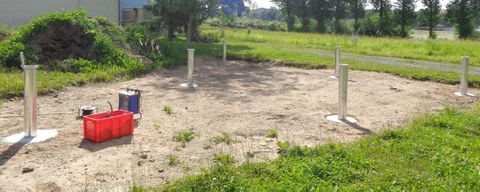Groundwater monitoring wells
Together with the spreading methods, the injection wells are one of the most popular MAR schemes used globally. In our field scale test site seven 5-inch-diameter and 14-m-deep monitoring wells were installed in order to perform different experiments to characterize the groundwater aquifer that is 7 to 9 m below the surface (depending of the season). The screen of the well is located between the 10 m and 13 m below the surface of each well. Their location is distributed in such a way, that specific tracer substances can be tracked when either injected in one of the wells or poured in the rapid infiltration unit basin.

Groundwater monitoring wells
The soil profile of the site is characterized to have in the upper 8 m a large portion of anthropogenic material (stones and construction wastes) that were disposed at the site as filling material. Below 8 m the texture of the site is predominantly gravely increasing the transmissivity of the groundwater flow. The groundwater system is in an extreme dependence to the river Elbe water stage.
Each well is equipped with a multiparameter sensor SENSOdive with an integrated Datalogger LogTransfer 6-compact which has the feature for a GPRS or GSM information transmission. The sensors allow the measurement in time of the following parameters in its given intervals:
- Water column (0 – 50 m)
- Temperature (-25 – 40°C)
- Electrical conductivity (0 – 20 mS/cm)
- pH (0 – 14)
- Dissolved oxygen (0 – 60 mg/L)
Besides water samples can be collected manually (with a bailer) or mechanically (with MP1 pump) for specific lab analyses (e.g. ions, metals, pH, DOC). For pumping of high rates of groundwater we count with a T.I.P. AJ 4 Plus diving pump that can pump up to 5 500 L/h.
With these features we are able to perform tracer experiments to determine in a very accurate way the flow direction and velocity of the groundwater in time. This is extremely useful also for the calculation of recovery rate for ASR and ASTR-related experiments and its dependence to the water temperature. On demand, we can also use the groundwater monitoring wells to perform further general hydrogeological surveys.
